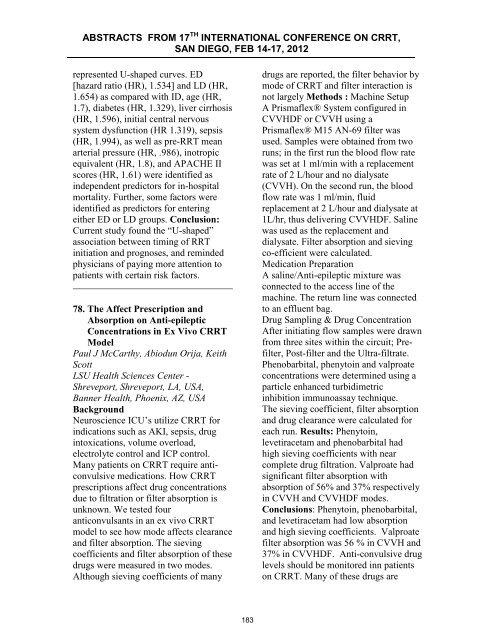ABSTRACTS from 16th International COnference on ... - CRRT Online
ABSTRACTS from 16th International COnference on ... - CRRT Online
ABSTRACTS from 16th International COnference on ... - CRRT Online
You also want an ePaper? Increase the reach of your titles
YUMPU automatically turns print PDFs into web optimized ePapers that Google loves.
<str<strong>on</strong>g>ABSTRACTS</str<strong>on</strong>g> FROM 17 TH INTERNATIONAL CONFERENCE ON <strong>CRRT</strong>,<br />
SAN DIEGO, FEB 14-17, 2012<br />
represented U-shaped curves. ED<br />
[hazard ratio (HR), 1.534] and LD (HR,<br />
1.654) as compared with ID, age (HR,<br />
1.7), diabetes (HR, 1.329), liver cirrhosis<br />
(HR, 1.596), initial central nervous<br />
system dysfuncti<strong>on</strong> (HR 1.319), sepsis<br />
(HR, 1.994), as well as pre-RRT mean<br />
arterial pressure (HR, .986), inotropic<br />
equivalent (HR, 1.8), and APACHE II<br />
scores (HR, 1.61) were identified as<br />
independent predictors for in-hospital<br />
mortality. Further, some factors were<br />
identified as predictors for entering<br />
either ED or LD groups. C<strong>on</strong>clusi<strong>on</strong>:<br />
Current study found the “U-shaped”<br />
associati<strong>on</strong> between timing of RRT<br />
initiati<strong>on</strong> and prognoses, and reminded<br />
physicians of paying more attenti<strong>on</strong> to<br />
patients with certain risk factors.<br />
78. The Affect Prescripti<strong>on</strong> and<br />
Absorpti<strong>on</strong> <strong>on</strong> Anti-epileptic<br />
C<strong>on</strong>centrati<strong>on</strong>s in Ex Vivo <strong>CRRT</strong><br />
Model<br />
Paul J McCarthy, Abiodun Orija, Keith<br />
Scott<br />
LSU Health Sciences Center -<br />
Shreveport, Shreveport, LA, USA,<br />
Banner Health, Phoenix, AZ, USA<br />
Background<br />
Neuroscience ICU’s utilize <strong>CRRT</strong> for<br />
indicati<strong>on</strong>s such as AKI, sepsis, drug<br />
intoxicati<strong>on</strong>s, volume overload,<br />
electrolyte c<strong>on</strong>trol and ICP c<strong>on</strong>trol.<br />
Many patients <strong>on</strong> <strong>CRRT</strong> require antic<strong>on</strong>vulsive<br />
medicati<strong>on</strong>s. How <strong>CRRT</strong><br />
prescripti<strong>on</strong>s affect drug c<strong>on</strong>centrati<strong>on</strong>s<br />
due to filtrati<strong>on</strong> or filter absorpti<strong>on</strong> is<br />
unknown. We tested four<br />
antic<strong>on</strong>vulsants in an ex vivo <strong>CRRT</strong><br />
model to see how mode affects clearance<br />
and filter absorpti<strong>on</strong>. The sieving<br />
coefficients and filter absorpti<strong>on</strong> of these<br />
drugs were measured in two modes.<br />
Although sieving coefficients of many<br />
drugs are reported, the filter behavior by<br />
mode of <strong>CRRT</strong> and filter interacti<strong>on</strong> is<br />
not largely Methods : Machine Setup<br />
A Prismaflex® System c<strong>on</strong>figured in<br />
CVVHDF or CVVH using a<br />
Prismaflex® M15 AN-69 filter was<br />
used. Samples were obtained <str<strong>on</strong>g>from</str<strong>on</strong>g> two<br />
runs; in the first run the blood flow rate<br />
was set at 1 ml/min with a replacement<br />
rate of 2 L/hour and no dialysate<br />
(CVVH). On the sec<strong>on</strong>d run, the blood<br />
flow rate was 1 ml/min, fluid<br />
replacement at 2 L/hour and dialysate at<br />
1L/hr, thus delivering CVVHDF. Saline<br />
was used as the replacement and<br />
dialysate. Filter absorpti<strong>on</strong> and sieving<br />
co-efficient were calculated.<br />
Medicati<strong>on</strong> Preparati<strong>on</strong><br />
A saline/Anti-epileptic mixture was<br />
c<strong>on</strong>nected to the access line of the<br />
machine. The return line was c<strong>on</strong>nected<br />
to an effluent bag.<br />
Drug Sampling & Drug C<strong>on</strong>centrati<strong>on</strong><br />
After initiating flow samples were drawn<br />
<str<strong>on</strong>g>from</str<strong>on</strong>g> three sites within the circuit; Prefilter,<br />
Post-filter and the Ultra-filtrate.<br />
Phenobarbital, phenytoin and valproate<br />
c<strong>on</strong>centrati<strong>on</strong>s were determined using a<br />
particle enhanced turbidimetric<br />
inhibiti<strong>on</strong> immunoassay technique.<br />
The sieving coefficient, filter absorpti<strong>on</strong><br />
and drug clearance were calculated for<br />
each run. Results: Phenytoin,<br />
levetiracetam and phenobarbital had<br />
high sieving coefficients with near<br />
complete drug filtrati<strong>on</strong>. Valproate had<br />
significant filter absorpti<strong>on</strong> with<br />
absorpti<strong>on</strong> of 56% and 37% respectively<br />
in CVVH and CVVHDF modes.<br />
C<strong>on</strong>clusi<strong>on</strong>s: Phenytoin, phenobarbital,<br />
and levetiracetam had low absorpti<strong>on</strong><br />
and high sieving coefficients. Valproate<br />
filter absorpti<strong>on</strong> was 56 % in CVVH and<br />
37% in CVVHDF. Anti-c<strong>on</strong>vulsive drug<br />
levels should be m<strong>on</strong>itored inn patients<br />
<strong>on</strong> <strong>CRRT</strong>. Many of these drugs are<br />
183
















